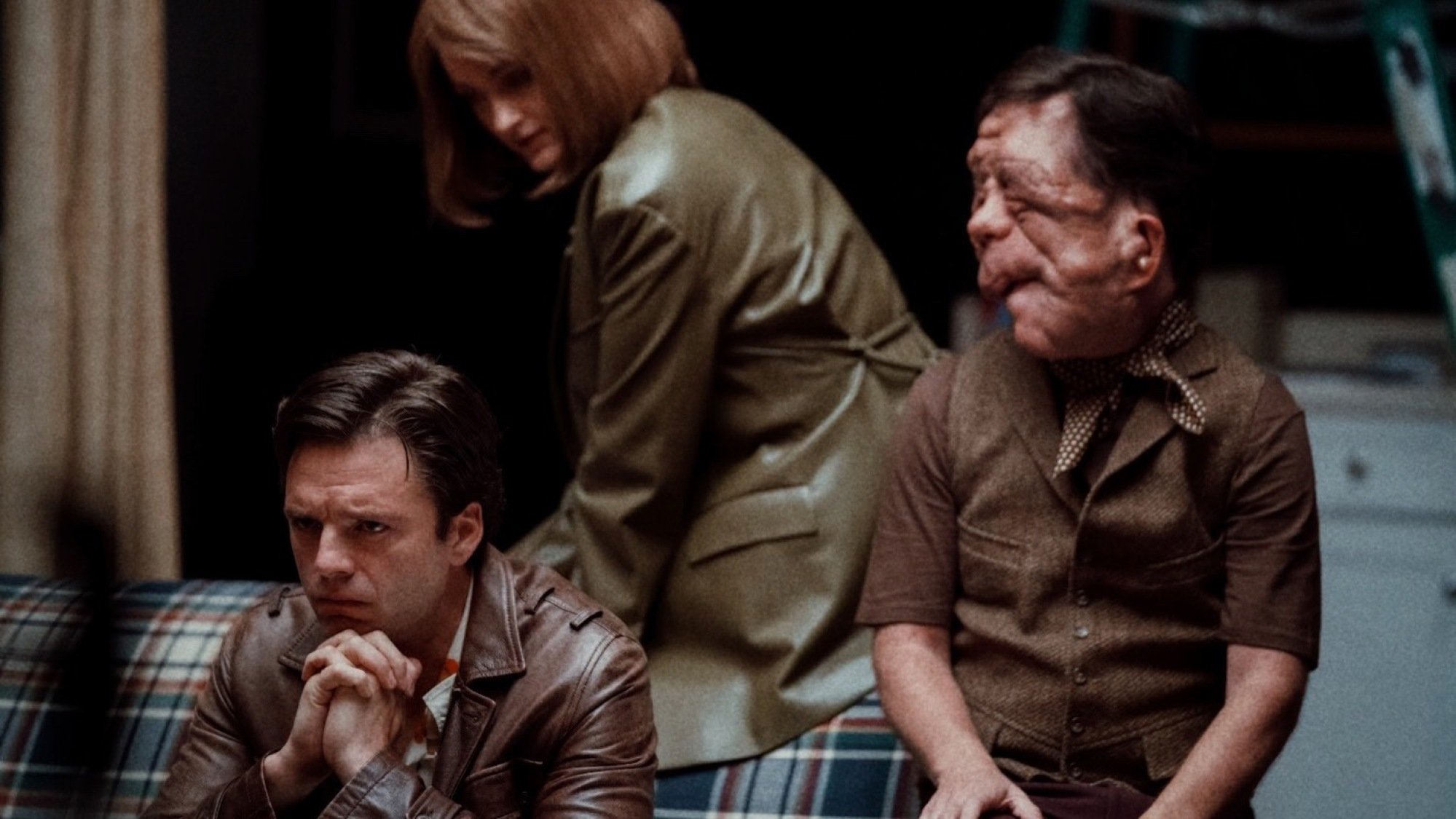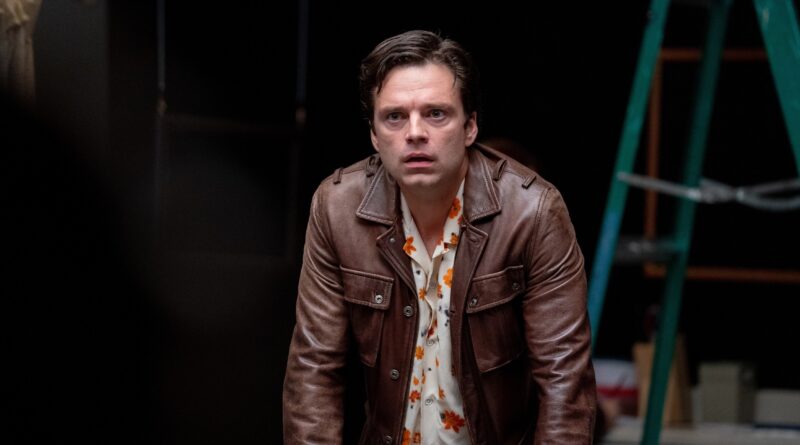‘A Different Man’ review: Sebastian Stan leads a stunning, self-reflexive drama on representation

A film that’s as much about its own gimmick as what that gimmick represents, Aaron Schimberg’s A Different Man casts Sebastian Stan as Edward, a man with pronounced facial differences that he eventually sheds through a miracle cure. However, when a now traditionally handsome Edward is cast in a play about his own life, the thorny question of artistic representation is broached in discomforting and hilarious ways.
However, the film doesn’t just draw attention to its decision to cast a pretty Hollywood face as a man with neurofibromatosis. That would be too easy an escape hatch, and too superficial a character study. Instead, it further complicates its questions of optics and politics by having a real actor with the same condition as Edward play a significant role in the film: Adam Pearson, who is known for appearing in Jonathan Glazer’s Under the Skin, after which he became a public advocate against “disfigurement stigma.” Pearson also starred in Schimberg’s 2018 film Chained For Life.
Pearson’s charismatic arrival, as a man who threatens to usurp the role of Edward from himself, sends Edward down a surreal emotional spiral. This on-screen clash of fiction and reality not only forces a strange, poignant self-reflection — for Edward, and for the film as a whole — but it also creates an fascinating meta-text that tells its own story about the actors in the film. It’s as much a tale of outward appearance as it is inner anxieties, a balance Schimberg strikes in careful ways as he crafts a stunning, distinctly New York comedy-drama about seeing oneself.
What is A Different Man about?

As Edward mopes around his apartment building, avoiding interactions as best he can, neighbors and various handymen alternatingly stare and offer polite but forced nods, as though it takes them special effort to avoid mentioning his differences. Edward is an actor, and not an altogether terrible one, though his roles are limited — not only by his appearance, but by his utter lack of self-confidence. Edward is halfway between invisible and hyper-visible; some don’t see him as fully human or as a viable romantic interest, while others stop and stare. He exists in limbo, trudging along day by day in his cramped, dilapidated New York apartment, which Schimberg and cinematographer Wyatt Garfield capture with a sense of grimy texture.
When Ingrid (Renate Reinsve), an attractive wannabe playwright from Europe, moves in next door, Edward’s prospects finally seem to change. After an initial skepticism, she takes a curious interest in him, and even offers to write a play for him to star in. However, his lack of conversational skills can’t help but create an awkward dynamic whenever they chat, as though he were some pet project for her to foster. Whatever the reality, Edward’s hunched-over body language and mousey demeanor hint at a kind of emotional impenetrability, as though he’ll read the worst in any situation because it’s the treatment he’s come to expect.
However, when a radical medical procedure verging on sci-fi body horror promises him a new life, Edward takes advantage of it in a very literal way, using his new face to start a brand new life and “killing off” the old Edward as though he were a fictional character. Time goes by, and he finds professional success in real estate — a forward-facing career — as a handsome man named Guy. But upon discovering Ingrid has written a play about his life, his curiosity gets the better of him, and he auditions with the help of a flimsy prosthetic mask.
Although Ingrid intends to cast someone with facial differences in the role, which she insists she didn’t base on any real person, Guy’s performance convinces her that he’s a miraculously a perfect fit, despite the fact that he doesn’t have any facial differences. He embodies all of Edward’s gestures and his physical and emotional anguish, even in scenes where Ingrid imagines conversations and inner monologues that don’t match what we’ve seen unfold between them in previous scenes, back when Guy was still Edward. The play, it seems, is born from Ingrid’s limited, patronizing perspective on Edward. The more this stage production goes on, the more Edward is forced to reckon with the past, and with realizations the film presents through stark, unsettling zooms into his bewildered expression. Despite having a new face, he may still be the same lonely, miserable person on the inside; perhaps now more than ever, since now he has no one with whom he can share the truth about who he once was.
Sebastian Stan delivers an impeccable performance.
As an actor playing two versions of a character, and subsequently playing a third, fictitious version — one he can’t play too well, lest he be found out — Stan is shouldered with a monumentally complex task. The prosthetics used to craft his differences allow him to emote within reason, but posture and movement are the tools through which he constructs Edward.
Not only does Stan perfect the ticks and eccentricities of a decidedly average actor (i.e. the real Edward pre-procedure), but when he’s reborn as Guy and cast as Ingrid’s conception of Edward, he crafts a sense of metamorphosis and regression. As the traditionally good-looking Guy playing this Edward, he delves deep into the vulnerable anxieties the character had begun to suppress as part of his new life, if only to try and bring some amount of honesty to a role he believes is dishonest.
These multi-layered complexities yield fascinating scenes of rehearsal and rewriting, bringing to the fore the film’s innate question of whether people far outside Edward’s physical and emotional experience are capable of telling his story. Ironically, the side the movie seems to come down on is a hesitant “maybe not,” at least as far as Ingrid is concerned. But Schimberg is not Ingrid, and he’s under no delusions of passing off Edward as a work of pure imagination.
This is largely because to anyone who’s seen Pearson before — whether in a movie, a TEDx Talk, or his numerous wrestling game show appearances — it’s clear that Edward, played by Stan, is distinctly modeled off Pearson, and the story practically exists so that he can show up in some capacity. The very knowledge that Pearson is involved with the film, and that Schimberg has worked with him before, colors A Different Man in a new light, and brings a wholly external context to Stan’s performance.
Of course, even without this knowledge, this context remains discomforting. Either way, Stan is playing a man he theoretically shouldn’t be, the same way Guy wearing prosthetics to play Edward ought to be seen as ill-advised to those around him (due to the problematic nature of “performing” physical disability and of robbing a disabled actor of a rare opportunity). However, Guy’s in-world explanation for Ingrid as to why he’s able to so deeply tap into the character of Edward is illuminating too. He concocts a lie about having once been best friends with someone with facial differences, which he claims not only gives him license to tell this story but allows him to tell it intimately and empathetically.
This is likely akin to Schimberg’s own reasoning too. Having become friends with Pearson after their collaboration on Chained For Life — a film that embodies similar debates — he has made an entire movie “about” him in numerous ways, treating him as both concept and human being… But who does Pearson play in the movie? Well, that’s an entirely different delight.
While watching the film, one might be inclined to believe it features the best work of Stan’s career; it even won him Berlin Film Festival’s Silver Bear for Best Leading Performance. However, even this praise is designed to be second-guessed at the back of one’s mind, since his role is one that projects a life of awkwardness and isolation onto Edward from people outside his experience — another idea the movie self-reflexively lampoons through debates between Guy and Ingrid. And just when it seems like this moral conundrum is one the film might avoid, it crafts an explosive alternative.
All of a sudden, Pearson shows up as an eccentric man named Oswald, an equally curious actor who stumbles upon Ingrid’s production. From the moment he appears, he delivers a performance so radical in its conception that he fundamentally changes what A Different Man is even about.
Adam Pearson is the film’s not-so-secret weapon.
Between films like The Elephant Man and Schimberg’s Chained for Life, facial differences on screen have been tied closely to pity and moroseness, an idea with which A Different Man constantly toys via Edward’s story. However, for anyone familiar with the real Pearson — as Schimberg no doubt is — he appears to be fairly upbeat and well-adjusted, despite speaking about the bullying in his past. The film’s plot is about a character with the same condition as Pearson, but Edward’s reality doesn’t seem to match Pearson’s in the slightest. So, in order to further highlight this disconnect, Schimberg writes Pearson a role that swings toward a completely different extreme that vastly reimagines the type of roles that ought to be available to actors regardless of differences, facial or otherwise.
The moment Oswald appears, he passive aggressively comments on Ingrid’s casting choice with his posh enunciation — Oswald, like Pearson, hails from London— a small detail that yanks the film in an even more head-spinning direction. Oswald is everything Edward wishes he could be: a brash playboy who reads people like a book, wears ostentatious shirts, and worms his way into social and professional circles with ease.
Pearson plays the role with slick, effortless panache. Each moment he’s on-screen is incredibly exciting; Oswald swallows every scene whole, practically sapping Edward’s energy as he’s forced to confront an uncanny reflection of himself who represents truths he might not want to face. Is this who Edward could’ve been all along? And, more importantly, is the lie he’s living worth it?
The more these questions torture Edward, the more surreal A Different Man becomes. Its very premise starts to feel like a fever dream, buoyed by escalating interpersonal tensions as Oswald forces his way into a consulting role on the play. Slowly but surely, he begins imposing his own, supposedly more “authentic” vision of Edward’s life on Edward’s own story, until the question of whether or not Oswald should simply replace Guy in the play becomes unavoidable. The concept of authenticity is so stretched and contorted by these developments that it becomes thematic taffy, with no distinct or solid form.
However, as A Different Man piles layer upon layer of confounding complication, it remains emotionally true to itself, which is to say, both to Edward’s increasingly paranoid self-reflection, and to Schimberg’s scrutiny of his own work (both this film, as well as Chained For Life). The film neither shies away from its innate surrealness, nor hesitates to get its hands dirty when it comes to real and vital conversations on whose stories can and should be told (and more importantly, how), even though it reflects each of its thoughts on the subject through a funhouse mirror.
By grounding its story in a character drama first and foremost, A Different Man anchors its many plot zig-zags, and its anxieties about its own existence, to a tangible emotional reality. Schimberg walks a razor-thin line between sincere self-critique and gaudy exploitation, and in the process, practically erases the boundary between them. The end result reveals uncomfortably funny new modes of on-screen representation, expressed in ways both innovative and exciting.
A Different Man was reviewed out of the Berlin International Film Festival.

